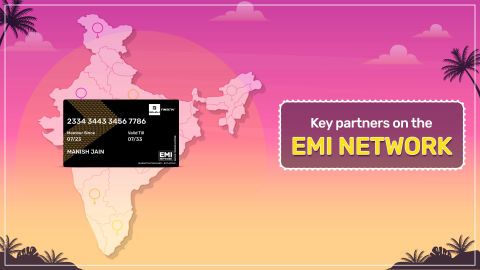Having a phone with good internal memory like 256GB can also help you keep files there freeing up space in your Google Account. If you want to buy an Android or iPhone on Easy EMIs, you can get it with a pre-approved loan from Bajaj Finserv. Check your loan eligibility today and keep shopping. Learn more on Bajaj Mall or visit one of 1.5 lakh+ partner stores across 4,000+ cities. Shop on Easy EMIs from Bajaj Finserv, with repayment options from 3 months to 60 months. Enjoy benefits like zero down payment and free home delivery on select products.
3 min
26-Jun-25
Your Google Account gives you access to a variety of services, including Gmail and Google Drive. Gmail storage is where all your emails and attachments are stored, while Google Drive is a cloud storage service where you can save files, photos, and documents. Both services share the same storage space, so managing your storage efficiently is important. If you find your storage running low, you can easily free up space by deleting large emails, emptying the Trash and Spam folders, and removing unnecessary files from Google Drive.
Having a phone with good internal memory like 256GB can also help you keep files there freeing up space in your Google Account. If you want to buy an Android or iPhone on Easy EMIs, you can get it with a pre-approved loan from Bajaj Finserv. Check your loan eligibility today and keep shopping. Learn more on Bajaj Mall or visit one of 1.5 lakh+ partner stores across 4,000+ cities. Shop on Easy EMIs from Bajaj Finserv, with repayment options from 3 months to 60 months. Enjoy benefits like zero down payment and free home delivery on select products.
Having a phone with good internal memory like 256GB can also help you keep files there freeing up space in your Google Account. If you want to buy an Android or iPhone on Easy EMIs, you can get it with a pre-approved loan from Bajaj Finserv. Check your loan eligibility today and keep shopping. Learn more on Bajaj Mall or visit one of 1.5 lakh+ partner stores across 4,000+ cities. Shop on Easy EMIs from Bajaj Finserv, with repayment options from 3 months to 60 months. Enjoy benefits like zero down payment and free home delivery on select products.
Why should you clear Gmail storage?
Clearing your Gmail storage is essential for maintaining the efficiency and functionality of your email account. Over time, your inbox can get filled with large attachments, old emails, and spams, which can take up valuable storage space. When your storage is full, you may miss important emails, experience slower performance, and be unable to send or receive new messages. By regularly clearing out unnecessary emails and attachments, you ensure that your Gmail account runs smoothly and that you have enough space for important communications. If your Google Account’s storage gets full, you can also buy space from Google at monthly charges. To avoid this, consider purchasing a mobile with higher internal memory.Do not forget to check latest offers on phones with 256GB internal memory or more before making your next purchase on Easy EMIs from Bajaj Finserv.
Open Google Account settings: On your computer or mobile device, open a web browser and go to the Google Account page by typing "myaccount.google.com" in the address bar.
Sign In: If you are not already signed in, enter your Google account email and password to log in.
Go to storage section: Once you are logged in, look for the section labelled "Storage" or "Manage your storage." This is usually found under the "Account" or "Data & personalization" tab.
View storage breakdown: In the storage section, you will see a breakdown of how your storage is being used. This includes the amount of space used by Gmail, Google Drive, and Google Photos.
Check detailed usage: For a more detailed view, click on the "View details" or "Manage storage" link. This will show you a more comprehensive breakdown of your storage usage, including large files and emails.
Identify large files and emails: Look for large files and emails that are taking up significant space. You can sort your files by size to easily identify the largest ones.
Delete unnecessary items: To free up space, delete any large files, emails, or photos that you no longer need. You can do this directly from the storage management page.
Empty trash and spam: Make sure to empty your Trash and Spam folders in Gmail, as these can also take up storage space.
Use Google’s storage management tool: Google offers a storage management tool that helps you find and delete items that are taking up space. You can access this tool from the storage section of your Google Account.
Monitor regularly: Regularly check your storage usage to ensure you have enough space for important emails and files. This will help you stay organized and avoid running out of storage.
Delete large emails: Open Gmail and type "has:attachment larger:10M" in the search bar. This will show emails with attachments larger than 10MB. Review these emails and delete the ones you no longer need.
Empty trash and spam: Go to the Trash folder and click on "Empty Trash now" to permanently delete all emails in the Trash. Do the same for the Spam folder by clicking on "Delete all spam messages now."
Remove unnecessary emails: Use filters like "older_than:1y" to find and delete emails older than one year. You can also search for specific types of emails, like promotions or social updates, and delete them in bulk.
Unsubscribe from unwanted emails: Open emails from senders you no longer wish to receive messages from and click the "Unsubscribe" link at the bottom of the email. This will reduce the number of unwanted emails you receive in the future.
Delete emails with large attachments: Search for emails with large attachments by typing "has:attachment larger:5M" in the search bar. Delete emails with large attachments that you no longer need.
Use Google’s storage management tool: Visit the Google One storage management page to see a breakdown of your storage usage and delete items directly from there.
Archive old emails: Instead of deleting, you can archive old emails to keep your inbox clean while still retaining the emails for future reference. Select the emails you want to archive and click the "Archive" button.
Delete sent emails with attachments: Go to the Sent folder and search for emails with attachments by typing "has:attachment" in the search bar. Delete sent emails with attachments that are no longer needed.
Delete unnecessary files: Open Google Drive and review your files. Delete any documents, images, or videos that you no longer need. To delete a file, right-click on it and select "Remove." Then, go to the Trash and click "Empty Trash" to permanently delete the files.
Use Google’s storage management tool: Visit the Google One storage management page to see a breakdown of your storage usage. This tool helps you identify large files and items that are taking up space, making it easier to decide what to delete.
Compress large files: If you have large files that you need to keep, consider compressing them to save space. Use file compression tools to reduce the size of documents, images, and videos before uploading them to Google Drive.
Delete duplicates: Check for duplicate files in Google Drive and delete them to free up space. Use third-party tools or manually search for duplicates by sorting files by name or size.
Manage Google Photos: Open Google Photos and review your photos and videos. Delete any that you no longer need. To delete a photo or video, select it and click the trash icon. Then, go to the Trash and click "Empty Trash" to permanently delete the items.
Use high-quality storage option: In Google Photos, go to Settings and select the "High quality" storage option instead of "Original quality." This option compresses photos and videos to save space without significantly reducing quality.
Move files to external storage: Consider moving large files from Google Drive to an external hard drive or another cloud storage service. This helps free up space in your Google Account while keeping your files accessible.
Regularly review and clean up: Make it a habit to regularly review your Google Drive and Photos to delete unnecessary files and manage storage. Set a reminder to clean up your storage every few months to prevent it from filling up.
Mobiles by brands
Mobiles by features
Mobiles by budget
5G mobiles by brands
5G Mobiles by budget
How to check your Google Account storage usage?
Here are the steps to check your Google Account storage usage:Open Google Account settings: On your computer or mobile device, open a web browser and go to the Google Account page by typing "myaccount.google.com" in the address bar.
Sign In: If you are not already signed in, enter your Google account email and password to log in.
Go to storage section: Once you are logged in, look for the section labelled "Storage" or "Manage your storage." This is usually found under the "Account" or "Data & personalization" tab.
View storage breakdown: In the storage section, you will see a breakdown of how your storage is being used. This includes the amount of space used by Gmail, Google Drive, and Google Photos.
Check detailed usage: For a more detailed view, click on the "View details" or "Manage storage" link. This will show you a more comprehensive breakdown of your storage usage, including large files and emails.
Identify large files and emails: Look for large files and emails that are taking up significant space. You can sort your files by size to easily identify the largest ones.
Delete unnecessary items: To free up space, delete any large files, emails, or photos that you no longer need. You can do this directly from the storage management page.
Empty trash and spam: Make sure to empty your Trash and Spam folders in Gmail, as these can also take up storage space.
Use Google’s storage management tool: Google offers a storage management tool that helps you find and delete items that are taking up space. You can access this tool from the storage section of your Google Account.
Monitor regularly: Regularly check your storage usage to ensure you have enough space for important emails and files. This will help you stay organized and avoid running out of storage.
How to free up Gmail storage space?
Here are some simple steps to free up Gmail storage space:Delete large emails: Open Gmail and type "has:attachment larger:10M" in the search bar. This will show emails with attachments larger than 10MB. Review these emails and delete the ones you no longer need.
Empty trash and spam: Go to the Trash folder and click on "Empty Trash now" to permanently delete all emails in the Trash. Do the same for the Spam folder by clicking on "Delete all spam messages now."
Remove unnecessary emails: Use filters like "older_than:1y" to find and delete emails older than one year. You can also search for specific types of emails, like promotions or social updates, and delete them in bulk.
Unsubscribe from unwanted emails: Open emails from senders you no longer wish to receive messages from and click the "Unsubscribe" link at the bottom of the email. This will reduce the number of unwanted emails you receive in the future.
Delete emails with large attachments: Search for emails with large attachments by typing "has:attachment larger:5M" in the search bar. Delete emails with large attachments that you no longer need.
Use Google’s storage management tool: Visit the Google One storage management page to see a breakdown of your storage usage and delete items directly from there.
Archive old emails: Instead of deleting, you can archive old emails to keep your inbox clean while still retaining the emails for future reference. Select the emails you want to archive and click the "Archive" button.
Delete sent emails with attachments: Go to the Sent folder and search for emails with attachments by typing "has:attachment" in the search bar. Delete sent emails with attachments that are no longer needed.
How to manage Google Drive and photos to save storage?
Here are some simple steps to manage Google Drive and Photos to save storage:Delete unnecessary files: Open Google Drive and review your files. Delete any documents, images, or videos that you no longer need. To delete a file, right-click on it and select "Remove." Then, go to the Trash and click "Empty Trash" to permanently delete the files.
Use Google’s storage management tool: Visit the Google One storage management page to see a breakdown of your storage usage. This tool helps you identify large files and items that are taking up space, making it easier to decide what to delete.
Compress large files: If you have large files that you need to keep, consider compressing them to save space. Use file compression tools to reduce the size of documents, images, and videos before uploading them to Google Drive.
Delete duplicates: Check for duplicate files in Google Drive and delete them to free up space. Use third-party tools or manually search for duplicates by sorting files by name or size.
Manage Google Photos: Open Google Photos and review your photos and videos. Delete any that you no longer need. To delete a photo or video, select it and click the trash icon. Then, go to the Trash and click "Empty Trash" to permanently delete the items.
Use high-quality storage option: In Google Photos, go to Settings and select the "High quality" storage option instead of "Original quality." This option compresses photos and videos to save space without significantly reducing quality.
Move files to external storage: Consider moving large files from Google Drive to an external hard drive or another cloud storage service. This helps free up space in your Google Account while keeping your files accessible.
Regularly review and clean up: Make it a habit to regularly review your Google Drive and Photos to delete unnecessary files and manage storage. Set a reminder to clean up your storage every few months to prevent it from filling up.
Mobiles by brands
| vivo mobile | LAVA phones | iQOO mobiles |
| TECNO mobiles | OnePlus mobiles | Samsung mobiles |
| realme mobiles | Nokia mobiles | Xiaomi mobiles |
| Infinix mobiles | motorola mobiles |
Mobiles by features
Mobiles by budget
5G mobiles by brands
| OPPO 5G mobiles | realme 5G mobiles | Nokia 5G mobiles |
| motorola 5G mobiles | Samsung 5G mobiles | Mi 5G mobiles |
| vivo 5G mobiles | Google 5G mobiles | iQOO 5G mobiles |
5G Mobiles by budget
| 5G mobiles under Rs. 15,000 | 5G mobiles under Rs. 20,000 | 5G mobiles under Rs. 25,000 |
| 5G mobiles under Rs. 30,000 | 5G mobiles under Rs. 40,000 |
Brands by budget (Rs. 20,000)
Frequently asked questions
How do I check what is using the most storage in Gmail?
To check what is using the most storage in Gmail, open Gmail and type "has:attachment larger:10M" in the search bar to find large emails with attachments. You can also visit the Google One storage management page to see a detailed breakdown of your storage usage across Gmail, Google Drive, and Google Photos. This will help you identify which emails and attachments are taking up the most space.
What happens if my Gmail storage is full?
If your Gmail storage is full, you will not be able to send or receive new emails. Additionally, you may experience slower performance and issues with syncing emails across devices. To avoid these problems, it is important to regularly manage your storage by deleting unnecessary emails and attachments and emptying the Trash and Spam folders.
Can I delete emails in bulk to free up space?
Yes, you can delete emails in bulk to free up space. Use search filters like "older_than:1y" to find and select multiple emails at once. You can also search for specific types of emails, such as promotions or social updates, and delete them in bulk. This helps quickly clear out large amounts of storage space.
Does deleting emails free up Google Drive storage?
Deleting emails can help free up storage space in your Google Account, as Gmail, Google Drive, and Google Photos share the same storage quota. By removing large emails and attachments, you can reduce the overall storage usage, which in turn frees up space in Google Drive and other Google services.
Can I buy phones with 256GB internal memory or more on EMI from Bajaj Finserv?
Yes, you can purchase phones with 256GB internal memory or more on Easy EMIs from Bajaj Finserv. If you are an existing user of the Bajaj Finserv Insta EMI Card:
1. Explore the range of smartphones on Bajaj Mall
2. Choose the preferred model and visit a Bajaj Finserv partner store to check it out in person
3. Use your Insta EMI Card and avail of Easy EMIs for affordable monthly payments
If you do not have it, check your eligibility for a Bajaj Finserv Insta EMI Card and take the first step towards enjoying the affordability and convenience of Easy EMIs.
1. Explore the range of smartphones on Bajaj Mall
2. Choose the preferred model and visit a Bajaj Finserv partner store to check it out in person
3. Use your Insta EMI Card and avail of Easy EMIs for affordable monthly payments
If you do not have it, check your eligibility for a Bajaj Finserv Insta EMI Card and take the first step towards enjoying the affordability and convenience of Easy EMIs.
Show More
Show Less
Bajaj Finserv App for all your financial needs and goals
Trusted by 50 million+ customers in India, Bajaj Finserv App is a one-stop solution for all your financial needs and goals.
You can use the Bajaj Finserv App to:
Apply for loans online, such as Instant Personal Loan, Home Loan, Business Loan, Gold Loan, and more.
You can use the Bajaj Finserv App to:
Apply for loans online, such as Instant Personal Loan, Home Loan, Business Loan, Gold Loan, and more.
- Explore and apply for co-branded credit cards online.
- Invest in fixed deposits and mutual funds on the app.
- Choose from multiple insurance for your health, motor and even pocket insurance, from various insurance providers.
- Pay and manage your bills and recharges using the BBPS platform. Use Bajaj Pay and Bajaj Wallet for quick and simple money transfers and transactions.
- Apply for Insta EMI Card and get a pre-approved limit on the app. Explore over 1 million products on the app that can be purchased from a partner store on Easy EMIs.
- Shop from over 100+ brand partners that offer a diverse range of products and services.
- Use specialised tools like EMI calculators, SIP Calculators
- Check your credit score, download loan statements, and even get quick customer support—all on the app.












